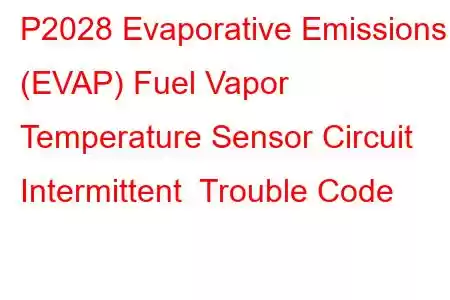P2028 EVAP Fuel Vapor Temp Sensor Circuit Intermittent
OBD-II Trouble Code Technical Description
Evaporative Emissions (EVAP) Fuel Vapor Temperature Sensor Circuit Intermittent
What does that mean?
This is a generic powertrain diagnostic trouble code (DTC) and typically applies to OBD-II vehicles. That may include but is not limited to vehicles from Mercedes Benz, VW, Audi, Subaru, Chevy, Dodge, BMW, Suzuki, Hyundai, Sprinter, etc. Anecdotally this code seems to be more commonly found on Mercedes-Benz vehicles.
Although generic, the exact repair steps may vary depending on year, make, model and powertrain configuration.
The Evaporative emissions (EVAP) system was introduced to vehicles for a few different reasons. Some of those included but are not limited to: reduced emissions expelled, slightly improved fuel efficiency, containing otherwise wasted fuel vapors. Not to mention consistently recycling unused/unburned fuel, pretty efficient isn't it?
That being said, the EVAP system requires a multitude of sensors, switches, and valves in order to maintain desired emissions. The ECM (Engine Control Module) actively monitors these and adjusts them according to system needs. Just as the name implies, the fuel vapor temperature sensor is used by the ECM to monitor the temperature of those unburned vapors that would otherwise be expelled to the atmosphere.
It is important to note that the EVAP system uses mostly plastic components to deliver the unburned fuel vapors to the engine to be burnt. You can imagine what kind of issues can occur when you expose plastic to the elements 24/7. Especially in particularly harsh winter conditions, these plastic components tend crack/split/break/clog. Food for thought.
The check engine light gets activated with P2028 and associated codes P2024, P2025, P2026, and P2027, when the ECM recognizes one or more electrical values missing and/or outside of a specific range within the EVAP fuel vapor temperature sensor or in one of the circuits involved. Hard to say wether this would be mechanical or electrical, the thing to keep in mind is, the overall health of the system involved, in this case, the EVAP system, is and always should be the priority.
Code P2028 is active when there is a fault coming and going. In other words , not consistently active.
What is the severity of this DTC?
As with most EVAP faults, I would say this is low on the severity scale. The entire system was mostly designed to decrease emissions to the atmosphere. Obviously it does a lot more in the meantime but all that being said, really the only thing negatively affected by this fault is the atmosphere. At the moment, I cannot think of any EVAP system problem that would be detrimental to the overall safety of the vehicle. This does NOT mean you can continue to drive the vehicle day in day out without addressing the issue. One problem always leads to another if left unsolved for too long.
What are some of the symptoms of the code?
Symptoms of a P2028 trouble code may include:
Failed state/provincial emission test CEL (check engine light) on Slight decrease in fuel efficiency Fuel smell Possible abnormal fuel filling symptoms (lengthy fill ups, cannot pull trigger on gas pump fully, etc.)What are some of the common causes of the code?
Causes for this P2028 fuel trim code may include:
Defective EVAP (Evaporative emissions) fuel vapor temperature sensor Broken or damaged EVAP fuel vapor temperature sensor wiring harness An electrical connection that is not consistent, e.g.: fuse not properly seated in designated slot, loose connector pin, broken tab on connector etc. Wire shorting to power Excessive resistance within the circuit ECM (Engine Control Module) issue Pin/connector problem. (corrosion, melting, broken lock tab etc..)How do I troubleshoot and repair a P2028 code?
Like
Read: 21


